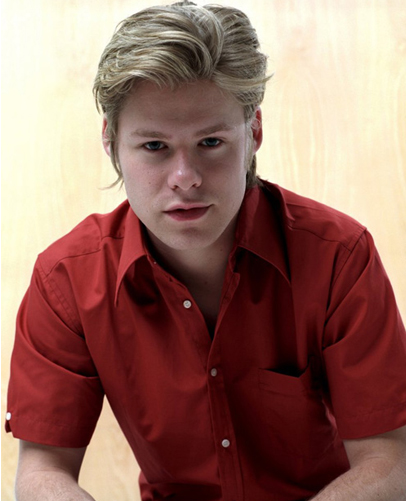
The play actually has two plots. On the one hand, Red is about Abstract Expressionist artist Mark Rothko's creating a series of murals for the Four Seasons Restaurant in the newly built Seagrams Building in New York City in 1958-59; on the other, the play is about the relationship between Rothko (right) and his young assistant Ken (left). Of his artistic generation's supplanting of Cubism and Surrealism in the 1940s, Rothko says to Ken, "The child must banish the father; Respect him, but kill him." But the statement comes back to haunt him as Ken champions Pop artists Andy Warhol, Robert Rauschenberg and Roy Lichtenstein as the rising new generation, intimating that Rothko and his ilk are passé.
Hired to clean brushes, mix paints, stretch canvas and apply ground color, aspiring artist Ken forces Rothko to reconsider the future of his works (especially the Seagrams murals). Having dined in the Four Seasons restaurant, I found myself wondering just what architects Philip Johnson and Mies van der Rohe were thinking when they gave Rothko $35,000 to paint a series of maroon, red and black paintings to adorn the walls of that serene Zen-like room. It is difficult to imagine dining in a room ringed with large red and black canvases! When Ken points out that people there will be eating, talking and laughing, not necessarily looking at the paintings (and after Rothko visits the room himself), the older artist finds himself in a quandary. And as the two argue over Rothko's philosophy—that "paintings need the viewer; they change, pulse, float" and that they "live and die in the eye of a sensitive viewer"—Ken transcends the role of son/student to find his own voice and essentially, "kill the father."
Lee Savage's terrific set evokes an artist's studio in downtown Manhattan down to the very last brush; sound designer Scott Killian provides city sounds outside the building to add to the verisimilitude. Against this backdrop (pun intended), Bob Ari as Rothko (above) and Randy Harrison as Ken (left) verbally spar, mix paint, furiously prepare a canvas with maroon paint and almost come to blows. Ken's admiration for Jackson Pollack sends Rothko into a wild dissertation on the symbiosis between Apollo (reason) and Dionysus (passion), which Ari delivers with a fervor bordering on rage. Embarking on a long list of things that are red, the two characters have a grand time, including Satan, Santa Claus and, of course, blood. And we learn that Rothko is scared by the absence of light that is the color black; for him black equals death.
Ari is by turns pompous, demanding, maddening, provocative and sympathetic, to be sure, as an aging Mark Rothko (although he wouldn't die of suicide until 1970). Harrison goes from being cowed by the older artist to valiantly standing up for himself, calling his mentor a "solipsistic bully," pretentious, "trying hard to be significant" and whose Seagram's murals are "a monumental act of self delusion"! You almost want to cheer for the young man at that point.
Ironically, "the richest bastards in the nation" who would dine at the Four Seasons are precisely the people who purchased paintings by Mark Rothko. Perhaps he never deemed these people worthy to look at—let alone own—one of his creations. Yet despite his protective attitude toward his paintings, the strictures he put on their method of display and his general curmudgeonly personality (he was probably clinically depressed and a dysfunctional personal life didn't help matters any), Mark Rothko is considered one of the pre-eminent artists of the 20th century.
Playwright John Logan, director Anders Cato, Bob Ari, Randy Harrison and the George Street Playhouse production team have mounted a play of great intellectual heft and dramatic tension. Red sits squarely in the tradition of classical drama: it teaches us something important, it is a window opening onto an unfamiliar world, yet it mirrors a relationship played out every day, in every family, every classroom, every office all over the world. For all those reasons, you should go to see Red. And think about bringing a teenager; this is a terrific opportunity to introduce him or her to a "straight" play. As director Cato says in his notes, "Rothko brought drama and theatrical revelation to the art of painting."
Red will be performed at the George Street Playhouse, 9 Livingston Avenue, New Brunswick, through February 26.
Written by Ruth Ross - Edited by Marcy